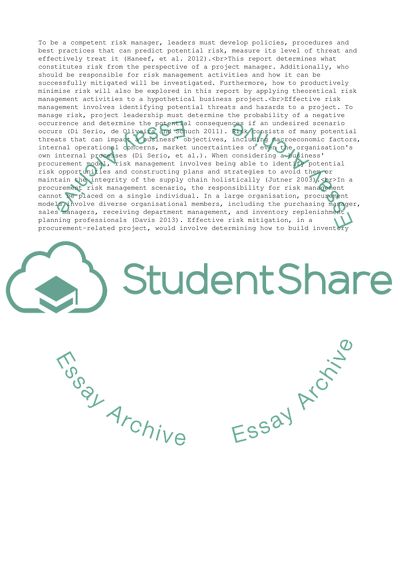Cite this document
(“What exactly is risk from the viewpoint of a project manager or Essay”, n.d.)
What exactly is risk from the viewpoint of a project manager or Essay. Retrieved from https://studentshare.org/management/1677239-what-exactly-is-risk-from-the-viewpoint-of-a-project-manager-or-business-with-responsibility-for-planning-organising-and-managing-projects-how-can-it-be-managed-effectively-and-who-should-be-responsible-for-this-task-you-are-required-to-critically-an
What exactly is risk from the viewpoint of a project manager or Essay. Retrieved from https://studentshare.org/management/1677239-what-exactly-is-risk-from-the-viewpoint-of-a-project-manager-or-business-with-responsibility-for-planning-organising-and-managing-projects-how-can-it-be-managed-effectively-and-who-should-be-responsible-for-this-task-you-are-required-to-critically-an
(What Exactly Is Risk from the Viewpoint of a Project Manager or Essay)
What Exactly Is Risk from the Viewpoint of a Project Manager or Essay. https://studentshare.org/management/1677239-what-exactly-is-risk-from-the-viewpoint-of-a-project-manager-or-business-with-responsibility-for-planning-organising-and-managing-projects-how-can-it-be-managed-effectively-and-who-should-be-responsible-for-this-task-you-are-required-to-critically-an.
What Exactly Is Risk from the Viewpoint of a Project Manager or Essay. https://studentshare.org/management/1677239-what-exactly-is-risk-from-the-viewpoint-of-a-project-manager-or-business-with-responsibility-for-planning-organising-and-managing-projects-how-can-it-be-managed-effectively-and-who-should-be-responsible-for-this-task-you-are-required-to-critically-an.
“What Exactly Is Risk from the Viewpoint of a Project Manager or Essay”, n.d. https://studentshare.org/management/1677239-what-exactly-is-risk-from-the-viewpoint-of-a-project-manager-or-business-with-responsibility-for-planning-organising-and-managing-projects-how-can-it-be-managed-effectively-and-who-should-be-responsible-for-this-task-you-are-required-to-critically-an.


